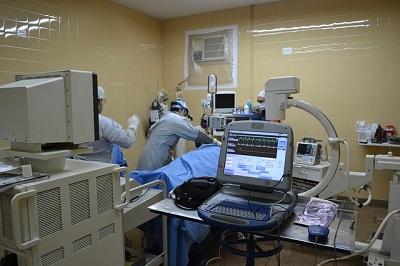Pay Special Attention to These Hydrosalpinx Symptoms!
The fallopian tubes are the ducts connecting the ovaries and the uterus, responsible for transporting and fertilizing eggs. When the fallopian tubes become inflamed, adhered, or blocked, fluid accumulates within the lumen and cannot be discharged typically, forming hydrosalpinx.

Hydrosalpinx is a common gynecological disease that can significantly impact a woman's reproductive health. Understanding its related symptoms and paying sufficient attention to them is crucial for early diagnosis and treatment.
Gynecology experts state that when women have issues with hydrosalpinx, their bodies will show some abnormal signs, and patients should pay close attention to any unusual changes in their bodies.
Pay special attention to these symptoms!
1. Lower abdominal pain
This pain may present as a persistent or intermittent dull ache or throbbing pain, usually worsening during menstruation, after sexual intercourse, or after physical exertion. The pain is generally located in the lower abdomen on both sides because the fallopian tubes are located on both sides of the pelvis. If the hydrosalpinx causes acute inflammation, the pain may become more severe, accompanied by fever and other systemic symptoms.
2. Menstrual abnormalities
Hydrosalpinx may affect ovarian function, leading to menstrual cycle disorders, increased menstrual flow, or prolonged periods. Some women may experience irregular bleeding between periods.
3. Increased vaginal discharge
Due to the presence of hydrosalpinx, vaginal discharge may become abnormally increased and may become thin in texture, sometimes even containing blood streaks.
4. Infertility
The fallopian tubes are where the egg and sperm meet and combine, and they also serve as the passage for the fertilized egg to be transported to the uterus. When hydrosalpinx occurs, its usual function is affected, hindering the combination of egg and sperm and the transportation of the fertilized egg, thus reducing the chances of conception and even causing infertility.
For some pregnant women, if hydrosalpinx is present, it may also increase the risk of ectopic pregnancy. The accumulation of fluid may disrupt the normal movement of the fertilized egg within the fallopian tube, causing it to implant and develop outside the uterus, leading to an ectopic pregnancy.
Why should these symptoms be given special attention?
Suppose lower abdominal pain continues to worsen and is not treated promptly. In that case, it may indicate the further spread of inflammation, leading to more severe pelvic inflammatory disease, increasing the difficulty of treatment and physical discomfort.
If menstrual abnormalities persist for a long time, it not only affects the quality of life but may also be a warning sign of endocrine disorders or other gynecological diseases. Ignoring it could delay the diagnosis and treatment, leading to more complex health problems.
If the abnormal increase in vaginal discharge is ignored, it may lead to worsening infections, causing ascending infections that affect the health of the uterus and pelvis.
Infertility and ectopic pregnancy both cause significant physical and emotional trauma to women. Infertility may bring tremendous psychological pressure to the family and individual, affecting marital relationships and quality of life. If an ectopic pregnancy is not detected and treated promptly, it can even be life-threatening.
In summary, when symptoms related to hydrosalpinx appear, seeking medical attention promptly for a comprehensive examination and diagnosis is essential. This enables the adoption of effective treatment measures to prevent the condition from worsening, thereby protecting reproductive health and ensuring safety.
Doctors usually perform gynecological exams, ultrasound scans, and hysterosalpingography to make a precise diagnosis. If hydrosalpinx is confirmed, the treatment method depends on the severity of the condition and the patient's fertility needs, among other factors.
For patients with mild symptoms and fertility needs, conservative treatment may be employed first. This includes using antibiotics to control inflammation, herbal medicine like Fuyan Pill, and physical therapy to promote fluid absorption.
If the hydrosalpinx is severe and affects fertility, surgical treatment may be necessary. Surgical options include salpingostomy and salpingectomy. After surgery, the Fuyan Pill can be taken to regulate and consolidate the effects.
You may also be interested in:
Hydrosalpinx: Frequent Checks and Excessive Anxiety Affect Pregnancy!
Hydrosalpinx: Frequent Checks and Excessive Anxiety Affect Pregnancy!
previous pageScientific Protection of Blockage: 3 Tips Women Need to Know
next page- Hydrosalpinx and IVF: What Are the Chances of Successful Embryo Implantation?
- Is Hysterosalpingography Harmful to the Body?
- Can Hydrosalpinx Be Thoroughly Drained by Aspiration Surgery?
- Pay Special Attention to These Hydrosalpinx Symptoms!
- Hydrosalpinx: Frequent Checks and Excessive Anxiety Affect Pregnancy!
Testimonials
- Adenomyosis with Ureaplasma Urealyticum Cured by Fuyan Pill
- Tubal blockage with hydrosalpinx can be cured by TCM shortly
- Fuyan Pill Helps A woman with Adenomyosis Get Pregnant
- A Woman with Hydrosalpinx Is Cured with Fuyan pill
- Pelvic Inflammatory Disease Testimonials
- Irregular Vaginal Bleeding and Endometrial Thickening Cured by Fuyan Pill
- Pruritus Vulvae and Frequent Urination: Mycoplasma Infection Cured after 2 Courses



